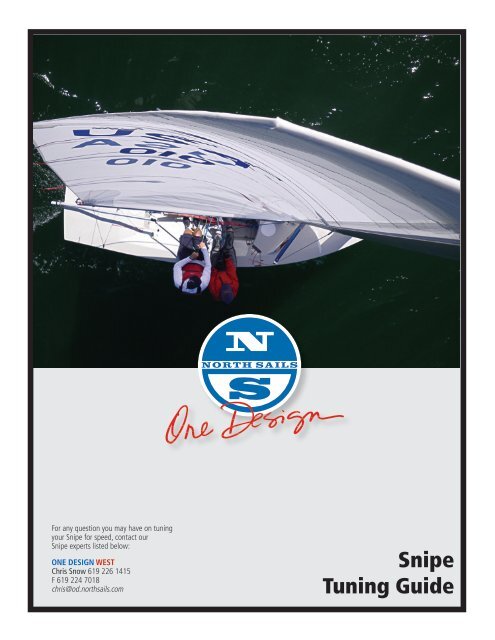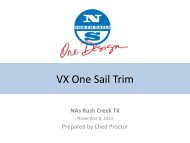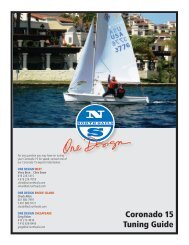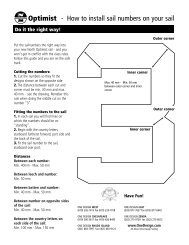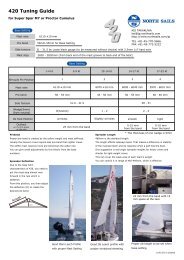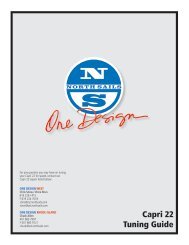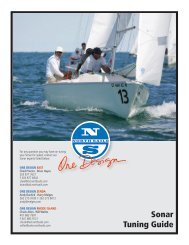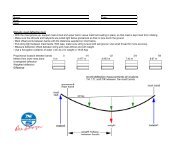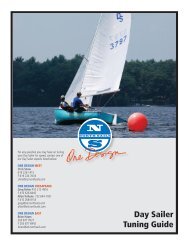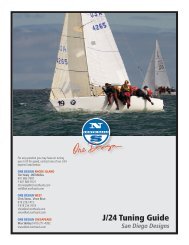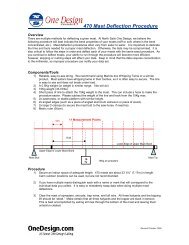You also want an ePaper? Increase the reach of your titles
YUMPU automatically turns print PDFs into web optimized ePapers that Google loves.
NORTH SAILS<strong>Snipe</strong> <strong>Tuning</strong> <strong>Guide</strong>In above 7-10 knots of wind the toptelltale will fly all the time and the topbatten should be trimmed parallel to theboom.CUNNINGHAMThe main cunningham controls thefore and aft position of the draft in thesail. Keep it loose until you begin to beoverpowered and then tighten it to openthe leech of the main by moving the draftforward in the sail.OUTHAULIn all but the very lightest conditions theouthaul should be tight when sailingupwind. Downwind let it off about 2-3”to make the bottom of the main morepowerful and to open up the shelf foot inthe bottom of the sail.BOOM VANGThe boom vang is used to hold the boomdown when the mainsheet is eased and tobend the mast and depower the main in abreeze. We leave the vang completely slackuntil we are hiking hard. Then we take theslack out of it so that when a puff hits wecan ease the boom slightly with out losingleech tension. As the breeze picks up morewe will pull the mast back to the aft markat the deck and trim the vang harder. Thisbends the mast and flattens the main andlets us play the mainsheet in the puffs without loosing main leech or jib luff tension.Downwind, you want to use the vangto keep the top batten parallel to theboom. Ease the vang substantially beforereaching the weather mark to make sureyou don’t break your boom in a breeze. Insome conditions, mostly light air and flatwater, the vang can be quite loose withthe top batten outside of parallel, whichallows you to sail a bit by the lee. In heavyair this makes the boat unstable and canresult in the dreaded “death roll”.TRAVELERIn most conditions, even heavy air, thetrend lately is to keep the traveler inthe middle of the boat. Make sure yourmainsheet bridle is set up so the “y” ofit goes slightly inside the boom. Thiswill keep the boom centered in light airwithout putting too much tension on theleech of the main.As the breezes builds and the boat getsoverpowered you may find it helpful todrop traveler until the helm of the boat isneutral and the boat is flat.Others will find vang sheeting preferable.With vang sheeting you tighten the vangto keep the boon down and the tensionon the leech when the mainsheet is eased.Make sure to have the mast back at theaft mark when vang sheeting to keep thejib's luff tight.PUSHER/PULLERThe mast pusher/puller controls the bendin the lower part of the mast and has bigeffect on rig tension. In light air (crewinside the boat) we push the mast forwardto the forward deck mark. This bends themast and opens the leech of the main.It also sags the jib luff giving you morepower for light air.As soon as the crew and skipper are sittingon the windward side of the boat wemove the mast back to the neutral markto power up the sails. As the breeze builds,we will pull the mast back more at thedeck to counteract the forces of the vang.A note on soft vs. stiff masts: As the breezereally builds (15+ knots) softer mastowners will want to keep the mast back atthe aft mark. This is because the forces ofthe vang cause the softer masts to reallybend down low and the mast must be heldback at the deck to keep the softer mastsfrom over bending.Stiffer mast owners will want to let themast go back forward to the neutral markwhen the breeze builds. The stiffer mastsdo not bend as much down low and needto be let back forward as the breeze buildsto help depower the main.Jib TrimSHEETTo help judge the trim of the jib your <strong>North</strong><strong>Snipe</strong> jib has a leech telltale sewn on it 1/3of the way down the leech. The sail alsocomes with a trim stripe on the clew. Tostart set the jib lead so that the sheet islined up with the trim lime on the clew ofthe jib. From there you will want to finetunethe lead so that the telltales on theluff of the jib break evenly (watch throughspreader window). Move the lead forwardif the top luffs first. Move the lead back ifthe bottom luffs first.After getting the lead position correct, wewant to trim the jib in so that the telltaleon the leech is just on the verge of stalling.You will need to adjust the tension on thejib sheet constantly as the wind builds andeases to keep the telltale just on the edgeof stalling.You may also want to make a mark oneach side of the splash rail 15” out fromthe centerline of the boat. The foot of thejib will fall in this vicinity upwind and thismark can be used as a reference point forjib trim.Visit our web site at www.<strong>One</strong><strong>Design</strong>.com for the latest <strong>Snipe</strong> news and tuning tips.© <strong>North</strong> <strong>Sails</strong> <strong>One</strong> <strong>Design</strong>. All rights reserved.4
NORTH SAILS<strong>Snipe</strong> <strong>Tuning</strong> <strong>Guide</strong>JIB CLOTHThe jib cloth tension should be tightenedjust enough so that there are always veryslight wrinkles in the luff of the sail. In veryheavy wind you will want to add tensionand make the luff of the jib smooth toopen the leech of the sail.JIB HALYARDBe sure your jib halyard has at least10-12” of throw in it. You will also wantto make sure that the halyard is clearlymarked at the up position so you caneasily get the halyard set in the correctposition at mark roundings.Dead downwind let the halyard all the wayoff to project the jib as far to windwardas possible. When reaching with the poleup you will find it fast to tighten the jibhalyard 1/3 to 1/2 the way to tighten theluff of the sail and make the sail morepowerful and easier to steer to.Contact <strong>North</strong> <strong>Sails</strong>Many thanks for purchasing <strong>North</strong> <strong>Sails</strong>.This tuning guide was compiled withthe help many National, <strong>North</strong> Americanand World Champion’s assistance andrepresents the latest thinking on sailing a<strong>Snipe</strong> fast.Please give any member of the <strong>North</strong><strong>Snipe</strong> team a call if you have anyquestions. We look forward to helping youget the most from your boat. Good Luck!NORTH SAILS ONE DESIGN QUALITY CONTROL CHECK<strong>Snipe</strong>MAINSAILJIBCornersCornersCunninghamWireStanchion patchTelltalesRoyalty (national/international)Royalty (national/international)NumbersLeech telltalesCountry Code<strong>North</strong> LogoBattensBagLeech TelltalesInsignia<strong>North</strong> LogoBagChecked by: __________________________________Date: ____ / ____ / ____For tuning information and completedetails on how to setup your <strong>Snipe</strong> sailscontact the <strong>North</strong> <strong>Snipe</strong> experts listed onthe cover os this guide.Good Sailing!Visit our web site at www.<strong>One</strong><strong>Design</strong>.com for the latest <strong>Snipe</strong> news and tuning tips.© <strong>North</strong> <strong>Sails</strong> <strong>One</strong> <strong>Design</strong>. All rights reserved.5


